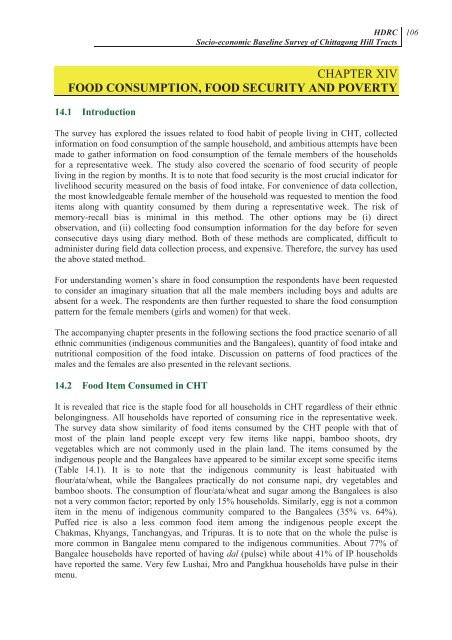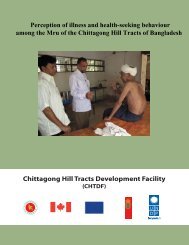Socio-economic Baseline Survey of Chittagong Hill Tracts - chtdf
Socio-economic Baseline Survey of Chittagong Hill Tracts - chtdf
Socio-economic Baseline Survey of Chittagong Hill Tracts - chtdf
- No tags were found...
You also want an ePaper? Increase the reach of your titles
YUMPU automatically turns print PDFs into web optimized ePapers that Google loves.
HDRC<strong>Socio</strong>-<strong>economic</strong> <strong>Baseline</strong> <strong>Survey</strong> <strong>of</strong> <strong>Chittagong</strong> <strong>Hill</strong> <strong>Tracts</strong>CHAPTER XIVFOOD CONSUMPTION, FOOD SECURITY AND POVERTY10614.1 IntroductionThe survey has explored the issues related to food habit <strong>of</strong> people living in CHT, collectedinformation on food consumption <strong>of</strong> the sample household, and ambitious attempts have beenmade to gather information on food consumption <strong>of</strong> the female members <strong>of</strong> the householdsfor a representative week. The study also covered the scenario <strong>of</strong> food security <strong>of</strong> peopleliving in the region by months. It is to note that food security is the most crucial indicator forlivelihood security measured on the basis <strong>of</strong> food intake. For convenience <strong>of</strong> data collection,the most knowledgeable female member <strong>of</strong> the household was requested to mention the fooditems along with quantity consumed by them during a representative week. The risk <strong>of</strong>memory-recall bias is minimal in this method. The other options may be (i) directobservation, and (ii) collecting food consumption information for the day before for sevenconsecutive days using diary method. Both <strong>of</strong> these methods are complicated, difficult toadminister during field data collection process, and expensive. Therefore, the survey has usedthe above stated method.For understanding women’s share in food consumption the respondents have been requestedto consider an imaginary situation that all the male members including boys and adults areabsent for a week. The respondents are then further requested to share the food consumptionpattern for the female members (girls and women) for that week.The accompanying chapter presents in the following sections the food practice scenario <strong>of</strong> allethnic communities (indigenous communities and the Bangalees), quantity <strong>of</strong> food intake andnutritional composition <strong>of</strong> the food intake. Discussion on patterns <strong>of</strong> food practices <strong>of</strong> themales and the females are also presented in the relevant sections.14.2 Food Item Consumed in CHTIt is revealed that rice is the staple food for all households in CHT regardless <strong>of</strong> their ethnicbelongingness. All households have reported <strong>of</strong> consuming rice in the representative week.The survey data show similarity <strong>of</strong> food items consumed by the CHT people with that <strong>of</strong>most <strong>of</strong> the plain land people except very few items like nappi, bamboo shoots, dryvegetables which are not commonly used in the plain land. The items consumed by theindigenous people and the Bangalees have appeared to be similar except some specific items(Table 14.1). It is to note that the indigenous community is least habituated withflour/ata/wheat, while the Bangalees practically do not consume napi, dry vegetables andbamboo shoots. The consumption <strong>of</strong> flour/ata/wheat and sugar among the Bangalees is alsonot a very common factor; reported by only 15% households. Similarly, egg is not a commonitem in the menu <strong>of</strong> indigenous community compared to the Bangalees (35% vs. 64%).Puffed rice is also a less common food item among the indigenous people except theChakmas, Khyangs, Tanchangyas, and Tripuras. It is to note that on the whole the pulse ismore common in Bangalee menu compared to the indigenous communities. About 77% <strong>of</strong>Bangalee households have reported <strong>of</strong> having dal (pulse) while about 41% <strong>of</strong> IP householdshave reported the same. Very few Lushai, Mro and Pangkhua households have pulse in theirmenu.



